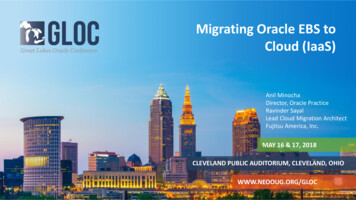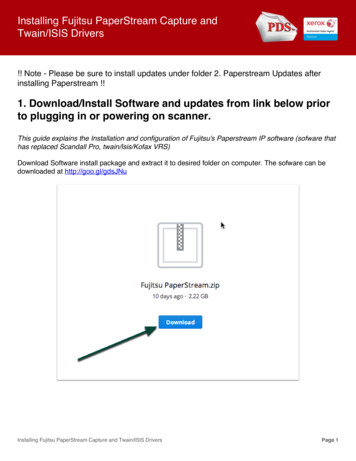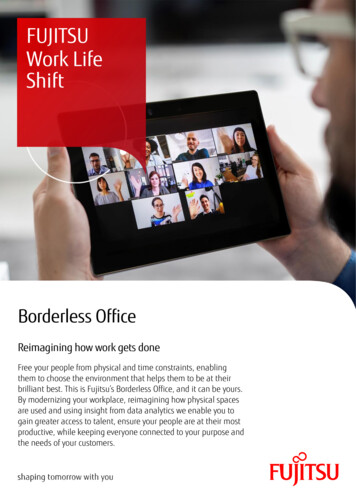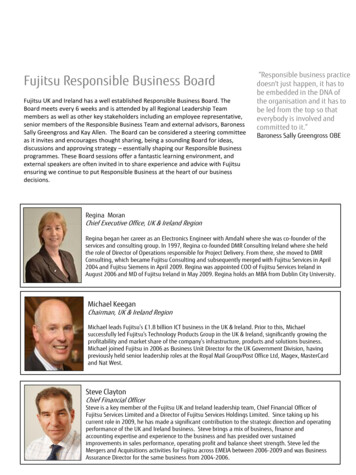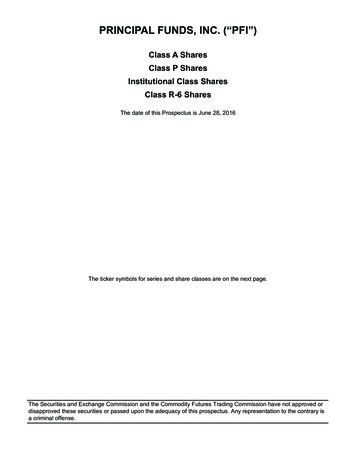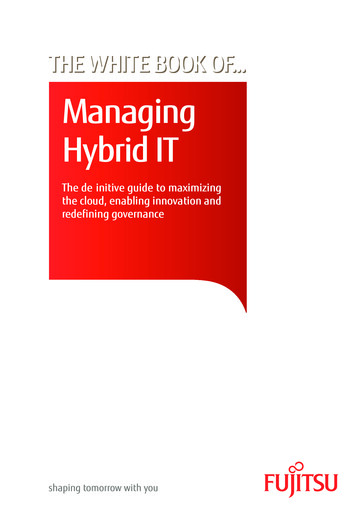
Transcription
THE WHITE BOOK OF.ManagingHybrid ITThe de initive guide to maximizingthe cloud, enabling innovation andredefining governance
THE WHITEBOOK OF.Managing Hybrid ITContentsAcknowledgements 4Preface 5Executive summary 6Introduction: A pivotal platform 101: Rethinking innovation and modernisation opportunities 122: Growing pains: Managing multiple clouds alongside existing IT 163: Navigating your cloud journey 264: Re-engineering for cloud 32Fujitsu and managing hybrid IT 36Managing hybrid IT speak: Key terms explained 383
AcknowledgementsWe would like to thank the following individuals for their valuable contributions toour research in developing this publication (listed alphabetically, by organization):l Mike Capone, Chief Information Officer and CorporateVice President of Product Development, ADPll Vishy Padmanabhan, Global IT Practice Partner,Bain & Companyll Jim Reavis, Co-founder and CEO, Cloud Security Alliancell Christopher Dailey, Head of Research, Datu Healthll Don Crabtree, Principal Infrastructure Architect,Delta Air Linesll Andrew Brabban, Director for Applications Portfolio, Fujitsull Cameron McNaught, Executive Vice President, Emerging Technologiesand Solutions, Global Delivery, Fujitsull Dr David DeHaven, Dean of the School of Information Technology,Kaplan Universityll Bill Limond, Chief Information Officer (interim),Medicines and Healthcare products Regulatory Agencyll Patricia Renzi, Principal, Millimanll Scott Skellenger, Vice President and Chief Information Officer,RainTree Oncology Servicesll Gareth Wylie, Head of Programmes, Telefónica Digitalll David Harkness, Vice President and Chief InformationOfficer, Xcel Energyll Jim Stikeleather, Co-author, Business Innovation in the Cloud:Executing on Innovation With Cloud Computing4
PrefaceThe White Book of Managing Hybrid IT is the latest in a series of research reports from Fujitsu thatseek to document cloud utilization within organizations, offering guidance on the application andmanagement of a technology where adoption is surging. It adds to our existing white books on cloudadoption, cloud security, big data, and mobilizing the enterprise.It is clear from both our research and the extensive discussions that my peers and I have held with CIOs,partners and industry analysts that cloud is now part of the standard delivery model for IT services inmany organizations today. From Fujitsu’s perspective, we see cloud as the natural platform fordelivering innovation and new types of applications, such as Big data, IoT, Mobility, as well asmodernizing existing ICT systems. Cloud has a key role in underpinning our vision of a human-centricintelligent society, one where social and business innovation is driven by the intelligent use ofinformation and communication technology.This fifth installment of our white book series, produced in collaboration with Longitude Research,reviews several key questions associated with this acceleration in the adoption of cloud and thesubsequent challenges that IT leaders are grappling with. In particular, it seeks to:lIdentify the issues that organizations are encountering as they look to manage multiplecloud solutions and integrate these into existing IT systems — a hybrid IT set-up;l Explore the strategies companies are using to manage the performance, security and cost ofthis new world of hybrid IT effectively, while still giving business-unit leaders the freedom touse cloud technology as a platform for innovation; Assess how the relationship of IT with the wider business may need to change in the long term, asorganizations adapt to the hybrid IT ecosystems they must build for the future; Define a new approach and solution for the integration, aggregation and management of thisgrowing portfolio of cloud services that is effective for a new model of service procurement anddeployment.The organizations that most readily accept the new reality of hybrid IT, and reconfigure themselves tomanage a radically different IT landscape, will find they are better positioned for the future. In particular,they will find themselves more able to innovate, less vulnerable to security risks and system-performanceissues, and more responsive to the demands of their respective markets. In short, they stand to gainsubstantial competitive advantage by embracing the hybrid IT model as the way forward.As cloud usage matures it is becoming clear that adopting cloud no longer delivers the level of competitiveadvantage it once did. In fact, not adopting cloud is, in many instances, becoming a competitivedisadvantage. The advantage now is from unlocking the value in existing data and systems and marryingthese to new ways of engaging customers and changing the way organizations operate etc.By providing a clear guide to the hybrid IT world that CIOs and other IT leaders are facing today, we hopethis book will be useful in helping to ensure success in your journey towards a deeper adoption of thecloud in your organization. As ever, we welcome your feedback and insights.Shobhit PorwalHead of Hybrid IT,Fujitsu America, Inc.5
Executive summaryl Cloud-computing systems are business as usual for most organizations, with deepeningadoption now focused on improving processes, increasing efficiency, and enablinginnovation. A significant number of organizations have moved beyond an experimentationstage with cloud, with widespread adoption that draws on multiple systems andproviders. Across a range of sectors, this deeper uptake is enabling fundamental businesstransformations, including wholly new processes, shorter supply chains, and faster routesto market for new products.ll Cloud has changed the way corporate technology projects are procured, deployed, andmanaged. The reality today in many organizations is that business-unit leaders are directlydriving many corporate IT projects, given the ease with which cloud systems can be bought.Businesses must react positively to this change by empowering these leaders to handleprocurement and deployment better, while finding new ways to manage the challengesthat these changes inevitably bring.ll New approaches to governance are needed to avoid replicating old, fragmented-enterpriseIT problems and to match the new pace of business. As their organizations make useof multiple cloud solutions – and multiple cloud providers – IT leaders are finding a growingneed to extend and adapt existing operational management and governance. The fact thatmost companies still retain a large investment in on-premises IT systems and applicationsfurther strengthens this need. Those who don’t respond will find themselves tackling greatercomplexity, new security risks, concerns over under-delivery, and integration problems.IT leaders also need to find ways to allow the rest of the business to adopt and implementnew applications quickly and easily, to avoid them simply bypassing IT altogether.ll IT can help by providing the framework for a new era. The creation of a governance frameworkto manage the full cloud lifecycle, from procurement to decommissioning, can help organizationsgrapple with the adaptation challenges ahead. Such a framework needs to ensure that, as newcloud services are introduced – and, increasingly, combined with existing systems and applications– there are clear policies on how these services are managed within the overall IT landscape.6
ll The hybrid IT model cannot succeed without the right toolkit. Governance models arenot the only areas that need to adapt; organizations also need the appropriate tools tomanage an increasingly hybrid IT environment. These tools need to ensure that theintegration of this hybrid environment is done properly, operational management iseffective, and that any associated risks are managed, while at the same time giving thewider business the freedom to innovate.ll The role of the CIO is shifting from that of IT provider and procurer to that of adviserand broker. CIOs remain drivers of their organizations’ IT strategies, but, equally, they needto recognize that the rest of the business needs greater freedom to decide which systemsto buy or use. In supporting this shift, many are reinventing themselves as brokers oradvisers. In the longer term, there may need to be a more fundamental shift of theIT function as a whole, such as to a federated model. In this approach, the CIO remains atthe center, owning a governance structure that helps guide the business, while becomingmore closely aligned to business needs through a brokering model that delivers a portfolioof cloud and non-cloud services.ll The public sector is often a leader when it comes to cloud procurement.Many public-sector organizations are already making significant use of the benefits of cloudand, given the sensitivities over the proper use and security of public data, many public-sectorbodies appear to be further down the road than their private-sector peers in adopting goodpractices. This is especially true of processes and governance relating to how cloud servicesare procured and how security is managed.7
Meeting the hybrid-ITmanagement challengeOur research suggests that as organizations become more heavily reliant on cloud,drawing on wide-ranging services from multiple providers, they will need to review theirapproach to service integration and end-to-end service management. This is especiallyso for a hybrid world of public and private cloud systems, along with other non-cloudapplications. In particular, attention needs to be given to the following three areas:1. Process and policiesl Creation of central cloud-procurement agreements for business leadersto work from.l The setting out of organizational standards and specifications that mustbe met by all cloud services.l Aligning corporate risk appetite with cloud-procurement andimplementation processes.l Governance framework that covers the entire cloud life cycle, from identificationand configuration to migration, management, and decommissioning.2. Operational management toolsll Providing a catalogue of available cloud and non-cloud resources for easyconsumption by business.ll Reporting on usage of cloud services, and consolidating associated costs and costallocation across the organisation.ll Integrating processes and data across hybrid IT systems.ll Monitoring and managing of all systems, with integration into existingservice-management tools.ll Protecting the data held in the cloud, as well as those in non-cloud systems.ll Managing identity and access centrally across the whole IT environment,including cloud services.3. Leadership and managementll Rethinking the CIO role – from IT provider and procurer to curator andbroker of services.ll Embedding a new culture by educating the wider business on managing riskand cloud-governance processes.ll Up-skilling the workforce to enable this new model of IT adoption to thrive.Technical IT staff are fundamental to this, but program managers, servicemanagers and procurement specialists all need to adapt as well.8
9
MANAGING HYBRID ITMaximizing the cloud: Enabling innovation, redefining governanceCloudgrowingIntroduction:A adoptionpivotalis platformCloud usage is surging as organizations seek greater competitive edgeAgilityInnovationNew applicationsCloud is theplatform for mobile,social and big data87%HR83%Customer care86%Finance85%MarketingIncreasing relianceGrowing investment 50% 58 7220132014billionHave already deployedcloud in their business1billionCorporate spending oncloud is growing rapidly²Deeper adoption within functions2015The majority of functionalunits will use cloud forsome element of theirbusiness by next year¹Cloud technology is no longer being spoken about in terms of “if” or “when” –“From a businessMoredifferentchallengesthe conversationhas movedonto “what next” and “how fast”. This realizationperspective, weare cloud createsOrganisations are identifyingnewchallengesasmanagingmultiple cloudsis leading organizations to rethinkdefinitely more openalongside traditional systems becomes the reality the way in which cloud solutions arebeing implemented, with an understanding that these systems will formto cloud servicesa critical, and often dominant, component of their IT architecture in future.today than we wereUnifiedRiskmanagementfive Newyearsdata ago”security, serviceReservations about cloud systems Cloudhaveandnotnon-cloudbeen entirely swept away –disruption and regulatoryDon Crabtree,Principalcompliancerisks emergeInfrastructure Architectat DeltaAirlinesIntegrationBusinessunitleaders say integrationissues prevent themgetting the best out ofdepartmental cloudssystems must be manageddata security, for instance, still remainsa major concern. But, for many, thealongside one anotherstrengths of cloud far outweigh its perceived weaknesses, and organizationsCost and non-cloud systems to address theseare learning how to combine cloudcontrolFaster cloudconcerns – for example by running workloads adoptionwherevermost appropriateincreasesneed to manageto meet their security and compliance considerations.Cloud investmentcosts transparentlytrends reflect businesses’ growing reliance on thetechnology: an April 2014report from Forrester Research projects a rise in corporate spending on cloudservices to US 72bn in 2014, up from US 58bn in 20132. “From a businessperspective, we are definitely more open to cloud services today than wewere five years ago,” says Don Crabtree, Principal Infrastructure Architect atDelta Airlines. “As a matter of fact, I think the business would probably liketo go much faster than IT would.”Managing a ‘hybrid IT’ landscapeA new kind of IT environment is rapidly emerging10Typical service tower modelService Delivery1. “Global cloud survey: The implementation challenge”, KPMG, February 2013.Newoutpaces‘hybridpredictions,IT’ modelForrester says”, Bloomberg, April 2014.2. “Cloud spending by companiesService Delivery
For many organizations, cloud technology has become a pivotal platform forinnovation, for both internal processes and external customer propositions.Our research has uncovered diverse examples of businesses implementing cloudsystems to gain competitive advantage. Some of these are profiled in this report,and they include decision-support tools, helping pharmaceutical companies toimprove cancer treatment, faster computational support for the M&A due-diligenceprocess, and the creation of a global HR platform, among other examples.Multiple clouds, multiple leadersThe upshot of this success is that many organizations are moving towardsa more advanced level of cloud maturity. In turn, many business-unit leadersare finding themselves taking the lead on adopting cloud-based services.“If you look at examples such as SalesForce.com , they afforded swathes offrustrated sales and marketing directors the opportunity to deliver innovativebenefits, such as enabling sales people to engage with customers in new ways –without having to turn the IT landscape upside down,” explains Andrew Brabban,Director for Applications Portfolio, Fujitsu.This trend of putting more power into the hands of other executives is creatingmyriad practical concerns for CIOs, from service-integration and data-securityconcerns through to optimizing capability as cloud adoption grows. In many cases,large organizations are creating scenarios whereby multiple business units arecontracting multiple cloud vendors – sometimes overlapping, and collectivelygiving rise to enormous complexity3.For their part, business leaders must learn how to strike the right balancebetween managing the risk and complexity associated with a heavier reliance oncloud, while enabling the wider organization to make full use of its potential. Thisis a problem that resonates with Gareth Wylie, the Head of Programsat Telefónica Digital, a subsidiary of the Spanish telecommunications firm nowincorporated back into the organisation’s core business. “We were one part of thebusiness that decided we needed to move quickly and implement a cloud solution.But others within the business have taken it upon themselves to do so in theabsence of a global system being delivered, and that leaves us with somedifficulties to overcome, given the reality of having multiple systems and tryingto stitch them together,” he says.“If you look at examplessuch as SalesForce.com,they afforded swathesof frustrated sales andmarketing directors theopportunity to deliverinnovative benefits,such as enabling salespeople to engage withcustomers in new ways– without having toturn the IT landscapeupside down”Andrew Brabban, Director forApplications Portfolio, FujitsuThis report seeks to highlight the methods that leading organizations areemploying to empower business units to adopt cloud systems, while still ensuringthe necessary operational management and governance. It offers guidancefor CIOs and other executives in creating a framework to achieve this, and pointsto practical examples of private- and public-sector organizations leading the wayin this area. Finally, it considers where this road will lead in the long term.3. “The entangled web of a multi-vendor cloud environment”, ITpreneurs, March 2013.11
1Rethinkinginnovation andmodernizationopportunities12
1Rethinking innovation andmodernization opportunitiesCloud is changing how companies innovate and evolve both their business modelsand their supporting IT systems. Even just a few years ago, IT’s role in enablinginnovation and supporting transformation typically required a structured approachand solid leadership commitment. IT teams had to spend time understandingthe needs of different business-unit leaders, before procuring and implementingthe infrastructure and applications needed to achieve those aims. This processtypically required long lead times, careful collaboration and communication,and ongoing leadership involvement. In short, the process was not particularlyconducive to greater innovation.By contrast, cloud makes it easy for organizations to try out different applicationsand technologies, with little cost or risk. Business leaders can quickly test differentsystems they believe may enhance how their functions operate, or that may pavethe way for wholly new approaches. Any that don’t work can simply be dropped —enabling a “quick to succeed, cheap to fail” approach.As Jim Stikeleather, co-author of Business Innovation in the Cloud: Executingon Innovation With Cloud Computing, explains, cloud is the platform that enablesorganizations to exploit new types of applications – especially for mobility, socialmedia and big data – to deliver exciting new results. “The primary interface betweenenterprises and their customers is now supported by the cloud, and it’s completelychanging the way companies engage with their market,” he says.Many others agree. Various executives interviewed for this report are putting thishugely powerful innovation and modernization platform to good use in diverseareas, both internally and externally, as the following examples highlight.Internal innovation and modernizationLeading organizations are using cloud systems to deliver wide-ranging internalbenefits, whether streamlining internal processes to increase efficiency and cut costs,or generating entirely new systems for business units to use.Telefónica Digital has done just that, transforming its HR function into a global digitaloperation. Mr Wylie says the company sought to improve performance throughbetter-targeted recruitment and development of its 6,000 employees. The task wasmade more difficult because the group had multiple HR teams across 16 countries,with different processes and different HR systems in place, ranging from very basictools to high-end Enterprise Resource Planning (ERP platforms. “Putting a new cloudsystem in place enabled HR to implement global processes, including performancemanagement, that have allowed us to better allocate our resources and target areasfor improvement,” says Mr Wylie.13
“Putting a new cloudsystem in place enabledHR to implementglobal processes,including performancemanagement, thathave allowed us tobetter allocate ourresources and targetareas for improvement”Gareth Wylie, Head ofProgrammes, Telefónica DigitalElsewhere, multinational actuarial firm, Milliman, is using the computing powerof cloud platforms to help smooth the M&A process. Patricia Renzi, Principalat the firm, highlights an example where, during an M&A analysis, the clientwanted additional sensitivity testing at the last minute. “Analysis that couldhave slowed the transaction down for two weeks and added significant costwas managed in one hour through contacting the ops team and usingthe cloud to access 10,000 compute engines,” she explains.Cloud technology is also driving the modernization of existing IT applications.While the majority of legacy applications were built many years before cloudservices existed, this should not prevent these systems from making use of thecloud. The most successful organizations are factoring this into their IT model,identifying legacy applications that could benefit from interaction with cloudservices, and modernizing them so that cloud services can be added, even whilethese applications remain on-premises.External engagementCloud services are also paving the way for enterprises to reshape their externalproposition to customers. Companies are using the cloud to create new typesof products and services; to take offerings to market more quickly; to open upnew channels to engage consumers; and flexibly to support new growth areaswithin the business, rapidly scaling up or down in line with their level of success.A recent marketing campaign run by a global soft-drinks manufacturerhighlights the potential. The firm wanted to accompany the launch of a newline of its drinks brand with an online marketing campaign aimed at a youngaudience, engaging them through social-media channels and via its website,culminating in a series of brand-sponsored events. The marketing teampotentially needed their IT platforms to support hundreds of thousands ofentrants and to help organize the events. “While their IT department wouldhave taken months to build the system they needed, by procuring a public cloudservice they were able to run the campaign inside six weeks,” explains Fujitsu’sMr. Brabban. “There was no need to build out support for thousands of users,and marketing could scale the service up as needed.” As well as supportinga valuable campaign, the faster and lower-cost approach enabled the company’smarketing team to run additional campaigns.14As organizations increasingly seek to realize the benefits of innovation andmodernization that cloud can deliver, IT must ensure it can provide thenecessary support. The wider business cannot act alone if the firm’s overallenterpriseIT architecture is to remain intact, but, in order for IT skills and managementcapabilities to be fully exploited, the function needs to keep pace with the rest ofthe business. This is especially true given that applications are beingmodernized to interact with cloud, or wholly migrated onto off-premisesplatforms.
1Rethinking innovation andmodernization opportunities“The primary interface between enterprisesand their customers is now supported by thecloud, and it’s completely changing the waycompanies engage with their market”Jim Stikeleather, co-author of Business Innovation in theCloud: Executing on Innovation With Cloud Computing15
2Growing pains:Managing multipleclouds alongsideexisting IT16
Cloud is theplatform for mobile,social and big data87%2HR83%Customer care86%Growing pains: ManagingmultipleFinanceclouds alongside existing IT85%MarketingAs the examples from the last chapter highlight, there is a clear caseIncreasing relianceGrowing investmentfor cloud-based innovation and transformation. But, while enterprisesin the early stages of cloud adoption may be able to fit cloud solutionsinto existing business processes with relative ease, those moving 58rapidly towards reliance on multiple cloud systems,often 72sourcedbillionbillionHave alreadydeployedfrom numerousproviders,are1 running into some 2013far more2014complexcloud in their businesschallenges. These typically fall into three broadgroups:integrationandCorporate spending onservice management; control and oversight;cloudandistheevolutionof keygrowingrapidly²roles. Each of these is discussed further here:Deeper adoption within functions 50%2015The majority of functionalunits will use cloud forsome element of theirbusiness by next year¹More cloud creates different challengesOrganizations are identifying new challenges as managing multipleclouds alongside traditional systems becomes the realityUnifiedmanagementRiskNew data security, servicedisruption and regulatorycompliance risks emergeBusiness unitleaders say integrationissues prevent themgetting the best out ofdepartmental cloudsCloud and non-cloudsystems must be managedalongside one anotherCostcontrolIntegrationFaster cloudadoption increasesneed to managecosts transparently‘hybrid1. Integrating andManagingmanagingahybridIT IT’ landscapeA new kind of IT environment is rapidly emergingIT must adaptEnd userApplicationsData centreNetworkEnd userApplicationsData centreThe importance of managing the service delivery of cloud and non-cloudsystems alongside one another in a unified management model isbecoming clear – organizations cannot afford to treat the two differentlyas cloud systems become more central to supporting the core business.NetworkAs the rate of cloud adoption accelerates, and the issue of integratingTypicalservicetowerexistingmodel on-premises systems becomesNew ‘hybrid IT’ modeland managingcloudalongsidemore complex, companies are realising that introducing new cloudServiceDeliveryService Deliveryservices is not alwayseasy.The integration issues this raises covera gamut of areas, including data, systems, and service integration,all of which must be dealt with effectively.Aggregate,integrate and managecloud services17
leaders say integrationissues prevent themgetting the best out ofdepartmental cloudsadoption increasesneed to managecosts transparentlyManaging a ‘hybrid IT’ landscapeA new kind of IT environment is rapidly emergingAggregate,integrate and managecloud servicesNetworkEnd userApplicationsData centreNetworkService DeliveryEnd userService DeliveryApplicationsNew ‘hybrid IT’ modelData centreTypical service tower modelComplexity arises not only when integrating new cloud solutions with“The IT hub willexisting ones, but also with on-premises data centers, applications,undoubtedly shrink asmustDaveadaptand ITplatforms.Harkness, CIO at Xcel Energy, says his teamthe weencloud and legacyGovernance models, integration processes and managementsystemsmust evolveadopts morecloudsystems. “We need to ensure we’re holding the data we need to hold,solutions, but that huband that we’re enabling the cloud vendors to hold the data thathas increasing numberswe’re willing to have them hold as well,” he says. “So there is quitea bit of integration work that we have to do before we’ve rolled outof spokes [cloud123most of these solutions.”services] coming offit, manyLeadershipof which willProcess policyTools systems managementDelta’s Mr Crabtree says one of the biggest challenges organizationsneed to communicateface is to ensure that cloud systems are communicating properly withand interface withone another, and with on-premises systems. “The IT hubone another.”will undoubtedly shrink as the organization adopts more cloudService DeliveryNetworkEnd userData centreBroker of services for otherbusiness leaders, whilebolstering relevant IT skillsApplicationssolutions, but that hub has increasing numbers of spokes [cloudservices] coming off it, many of which will need to communicateand interface with one another,” explains Mr Crabtree. Linking publiccloud services with enterprise systems can be challenging, given thedata-synchronisation issues involved. This task becomes even moreBusinessunitsempowered,New approachto managinghybriddifficultwherebusinessprocesses involvemultiplesystems. “Wherebut governancemakesit simpler,applications,safer and morea businessprocessframeworkis required to cut ITacrossmultipleensures maximum returncost effective to adopt multipleit further adds to the complexity of the application landscape, as welland minimum riskcloud services and manage theseas adding to the cost of implementing adds Telefónica’s Mr Wylie.Don Crabtree, PrincipalInfrastructure Architect,Delta Air LinesAggregate,integrate and managecloud servicesSystem integration is an issue that David DeHaven, Dean of the Schoolof Information Technology at Kaplan University, has also struggledininhisattemptto toimplementa newcloud-basedOrganizations need towithadaptseveralareasextract mostvaluefrom cloud: gaming platformfor students. “We worked with our vendor on integration, who haddone specific integrations in the past with a different online learningRe-engineering for cloud18Empowering businessinnovationGreater understandingof risk“The CIO should beleading the charge in leveragingthe cloud to make things work,
2Growing pains: Managing multipleclouds alongside existing ITplatform. An assumption was made that they would naturally be ableto integrate, but we discovered that this was not the case, and we hadto build the integration solution ourselves,” he explains.Where large numbers of cloud systems are involved, it is no longerviable to link services, processes and data through point-to-pointintegrations. Instead, a more sophisticated solution is required, basedon easily configured and open software tools, and which provides anintegration hub with pre-defined connectors that can be configuredquickly without lots of development expertise.Once the cloud and non-cloud systems are integrated, the nextchallenge for the CIO lies in providing end-t
Acknowledgements 4 Preface 5 Executive summary 6 Introduction: A pivotal platform 10 1: Rethinking innovation and modernisation opportunities 12 2: Growing pains: Managing multiple clouds alongside existing IT 16 3: Navigating your cloud journey 26 4: Re-engineering for cloud 32 Fujitsu and managing hybrid IT 36 Managing hybrid IT speak: Key terms explained 38

